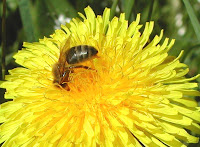[Note: This YABeeP webpage records the bees seen in and around the local area. Started in April 2010 the development of this page is very much a 'work in progress' - species will be added as members photograph, research and record them - please be patient.]
Bees are classified in the family Aculeata, part of the order Hymenoptera and are listed below according to their 3 general groupings - Solitary bees, Bumble bees and Honeybees. We have decided to also include other species of interest either because they mimic the bees (e.g. Bombylius major, a parasite of the solitary bee) or because they evolved from a similar species - e.g. wasps. Click on any photo to enlarge it.
A. Solitary Bees
There are over 200 species of Solitary bee in the UK and are generally grouped as ground nesting, cavity nesting and parasytic bees.
Species: Hairy-footed flower bee - Anthophora plumipes
Description: Active from March to late May. Flys with a darting movement - moving quickly then hovering. The male can be easily confused with a bumble bee although the female is all black with orange-yellow hind legs. The male is similar to Bombylius major, although the latter only has 2 wings being a fly which mimics a bee.
 |
| Female Anthophora plumipes entering nest in the mortar of Yatton church. Note orange hairs on hind tibia |
Link to BWARS pictures
Genus: Mining bee - Andrena
 Description: There are over 60 species of the Andrena mining bee in the UK. Mostly active April to early June. The female tunnels into ground to make nest in soil, often unnoticed in the grass of our gardens though they can have volcano like mounds surrounding the holes which are glued by a substance the bee excretes. The tunnel can be up to 12" deep with many branches where the female stores pollen & nectar and lays eggs in individual cells. The eggs do not hatch until the following spring. Some species share a common entrance but build separate branching chambers below. Whilst they do posess a sting it cannot puncture human skin so is harmless to children.
Description: There are over 60 species of the Andrena mining bee in the UK. Mostly active April to early June. The female tunnels into ground to make nest in soil, often unnoticed in the grass of our gardens though they can have volcano like mounds surrounding the holes which are glued by a substance the bee excretes. The tunnel can be up to 12" deep with many branches where the female stores pollen & nectar and lays eggs in individual cells. The eggs do not hatch until the following spring. Some species share a common entrance but build separate branching chambers below. Whilst they do posess a sting it cannot puncture human skin so is harmless to children. Pictures - Species probably Andrena nitida or Andrena haemorrhoa nesting in lawn in Yatton during May
- Link to the Garden Safari website for identification of the more common species of Mining bee.
B. Bumble Bees
There are around 20 species of bumble bee in the UK.
C. Honeybees
 |
| Apis meliffera |
Species: European honeybee - Apis meliffera
 |
| Apis meliffera with full pollen baskets |
Description: A true social bee common in the area and active year round though the colony goes into winter cluster so is rarely seen flying over the cold winter periods.
D. Bee mimics and others
Species: The Common Bee-fly - Bombylinus major
Species: The Common Bee-fly - Bombylinus major
 |
The Common Bee-fly (Bombylinus major) hovering to feed on Myosotis (Fotget-me-not) |
Adults feed on nectar, using their long proboscises whilst hovering beside a flower. Aubretia is one common garden plant frequently visited.
Note: All photographs on this page are originals © YABeeP







No comments:
Post a Comment